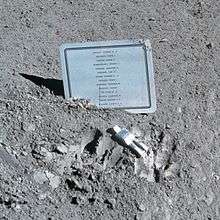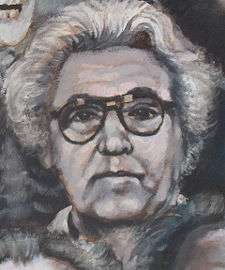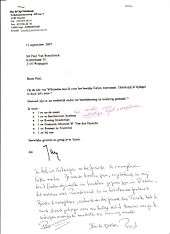Fallen Astronaut
 | |
| Medium | Aluminum |
|---|---|
| Dimensions | 8.5 cm (3.3 in) |
| Location | Moon, Hadley Rille |
Fallen Astronaut is an 8.5-centimeter (3.3 in) aluminium sculpture created by Paul Van Hoeydonck. It is a small stylized figure, meant to depict an astronaut in a spacesuit, intended to commemorate the astronauts and cosmonauts who have died in the advancement of space exploration. It was commissioned and placed on the Moon by the crew of Apollo 15 at Hadley Rille on August 1, 1971, next to a plaque listing the fourteen men known at the time to have so died.[1]
The crew kept the memorial's existence a secret until after completion of their mission. After public disclosure, the National Air and Space Museum requested and received a replica of the statue. Controversy soon followed, as Van Hoeydonck claimed a different understanding of the agreement made with the astronauts, and attempted to sell up to 950 copies of the statue. He finally relented under pressure from NASA, which has a strict policy against commercial exploitation of the US government space program.
Commission

Prior to his Apollo 15 lunar mission, astronaut David Scott met Belgian painter and printmaker Paul Van Hoeydonck at a dinner party. It was there agreed that Van Hoeydonck would create a small statuette for Scott to place on the Moon, though their recollections of the details disagree. Scott's purpose was to commemorate those astronauts and cosmonauts who had lost their lives in the furtherance of space exploration, and he designed and separately made a plaque listing fourteen American and Soviet names. Van Hoeydonck was given a set of design specifications: the sculpture was to be lightweight but sturdy, capable of withstanding the temperature extremes of the Moon; it could not be identifiably male or female, nor of any identifiable ethnic group. According to Scott, it was agreed Van Hoeydonck's name would not be made public, to avoid the commercial exploitation of the US government's space program.[2] Scott kept the agreement secret from NASA management prior to the mission, smuggling the statue aboard his spacecraft.
Van Hoeydonck recalls the agreement differently. According to an interview with him in Belgian newspaper Le Soir, the statue was supposed to be a representation of all mankind, not only fallen astronauts or cosmonauts. He claimed he did not know the statue would be used as a memorial for the fallen space-goers, and the name given to the work was neither chosen nor approved by him; he had intended the figure to be left standing upright. He also denies it was agreed he would remain anonymous.[2][3] Both his and Scott's versions of events are given in an article in Slate magazine in 2013.[2]
Placement on the Moon
During the Apollo 15 mission, near the completion of his work on the lunar surface on August 1, 1971, Scott secretly placed the Fallen Astronaut on the Moon, along with a plaque bearing the names of eight American astronauts and six Soviet cosmonauts who had died in service:
- Theodore C. Freeman (October 31, 1964, aircraft accident)
- Charles A. Bassett II (February 28, 1966, aircraft accident)
- Elliot M. See Jr. (February 28, 1966, aircraft accident)
- Virgil I. Grissom (January 27, 1967, Apollo 1 fire)
- Roger B. Chaffee (January 27, 1967, Apollo 1 fire)
- Edward H. White II (January 27, 1967, Apollo 1 fire)
- Vladimir M. Komarov (April 24, 1967, Soyuz 1 re-entry parachute failure)
- Edward G. Givens Jr. (June 6, 1967 automobile accident)
- Clifton C. Williams Jr. (October 5, 1967, aircraft accident)
- Yuri A. Gagarin (March 27, 1968, aircraft accident)
- Pavel I. Belyayev (January 10, 1970, disease)
- Georgiy T. Dobrovolsky (June 30, 1971, Soyuz 11 re-entry pressurization failure)
- Viktor I. Patsayev (June 30, 1971, Soyuz 11 re-entry pressurization failure)
- Vladislav N. Volkov (June 30, 1971, Soyuz 11 re-entry pressurization failure)[4]
Scott photographed the memorial, but waited for a post-mission press conference to publicly disclose its existence. Later, he noted that "Sadly, two names are missing (from the plaque), those of Valentin Bondarenko and Grigori Nelyubov."[5] He explained that the western world was unaware of their deaths, because of the secrecy surrounding the Soviet space program at the time. Also missing was the name of Robert Henry Lawrence, Jr., the first black astronaut and a USAF officer selected for the Manned Orbiting Laboratory program who was killed in a training accident in 1967.[6]
Controversy

After the crew disclosed the statuette's existence during their press conference, the National Air and Space Museum requested that a replica be made for public display. The crew agreed, on condition that it be displayed "with good taste and without publicity". The replica was given to the Smithsonian Institution on April 17, 1972, the day after CBS anchorman Walter Cronkite referred to the Fallen Astronaut and plaque as the first art installation on the Moon during the broadcast of the Apollo 16 launch.[7] It is now on display with a replica of the plaque[8] in the Museum's National Mall Building in the Space Race Wing, Gallery 114.
In May 1972, Scott learned that Van Hoeydonck planned to make and sell more replicas. Believing that this would be a violation of the spirit of their agreement, and NASA's policy against commercial exploitation of the space program, Scott tried to persuade Van Hoeydonck to refrain. It was advertised in a full-page advertisement in the July 1972 issue of Art in America magazine,[9][10] that 950 replicas of Fallen Astronaut signed by the sculptor would be sold by the Waddell Gallery of New York for $750 each;[11] a second edition, at a lower, unspecified price; and a catalog edition, at $5.[12]
After complaints from NASA about the intended sale, Van Hoeydonck retracted his permission for it and no statues were sold.[13]
On September 11, 2007, art journalist Jan Stalmans wrote Van Hoeydonck, asking him how many replicas were in existence. Van Hoeydonk returned a handwritten response on the letter, that 50 copies had been made, most of which were still in his possession, unsigned. Van Hoeydonck wrote that he had only ever received money for one copy of Fallen Astronaut, despite many purchase offers he had received (see the English translation of the letter).
See also
References
- Specific
- ↑ "Sculpture, Fallen Astronaut". Smithsonian National Air and Space Museum. Retrieved 17 July 2014.
- 1 2 3 Powell & Shapiro 2013
- ↑ Le Soir 17 July 2009, p. 19
- ↑ "images.jsc.nasa.gov". images.jsc.nasa.gov. 1971-08-01. Retrieved 2013-04-29.
- ↑ Leonov & Scott 2013, p. 313
- ↑ Oberg, James (2005-02-23). "The Unsung Astronaut". NBC News. Retrieved 2016-01-20.
- ↑ "Sculpture, Fallen Astronaut". si.edu.
- ↑ "Plaque, Fallen Astronaut and Cosmonaut, Reproduction". si.edu.
- ↑ Associated Press (21 July 1972). "Commercialism Taints Another Apollo Memento". Modesto Bee. p. 7.
- ↑ Check-Six.com – Fallen Astronaut – includes copy of July 1972 Art in America ad
- ↑ "NASA News Release 72-189". Collectspace.com. Retrieved 2013-04-29.
- ↑ Wieck, Paul (25 July 1972). "Anderson Will Probe Unauthorized Sales". Albuquerque Journal. p. 16.
- ↑ Van den Bussche 1980, pp. 16–17
- General
- Powell, Corey S.; Shapiro, Laurie Gwen (16 December 2013). "The Sculpture on the Moon". Slate (magazine).
- du Brulle, Christian; Vantroyen, Jean-Claude; Maury, Pierre (17 July 2009). "Une œuvre d'art sur la Lune ? Quelle extraordinaire galerie ! Quelle fascinante cimaise ! Quel rêve inaccessible". Le Soir (in French). Retrieved 20 December 2013.
- Van den Bussche, Willy (1980). Paul van Hoeydonck. Tielt: Lannoo. ISBN 90-209-0885-5.
- Leonov, Alexei; Scott, David (2013). Two Sides of the Moon: Our Story of the Cold War Space Race. Thomas Dunne Books. ISBN 978-1480449237.
External links
| Wikimedia Commons has media related to Fallen Astronaut plaque and sculpture. |
| Wikimedia Commons has media related to Paul van Hoeydonck. |
- Sculpture fabricated at Milgo / Bufkin
- Transcript of NASA News Release 72-189 (September 15, 1972), describing the origin of Fallen Astronaut and the subsequent controversy
- Official NASA photo of Fallen Astronaut on the Moon
- Apollo 15 Lunar Surface Journal
- Observatoire du Land Art (transcript of the book Goden & Astronaut, Banana Press, 1972 (statement, articles, photos))
- Von Hoeydonck's website
- Van Hoeydonck works at Whitford Fine Art
- See some works of Paul Van Hoeydonck
Coordinates: 26°07′56″N 3°38′02″E / 26.13222°N 3.63386°E